
PyEpics: Epics Channel Access clients with Python
Matthew Newville
Consortium for Advanced Radiation Sciences
University of Chicago
24-Oct-2014
A copy of these slides and instructions for the hands-on exercises are at:
http://cars9.uchicago.edu/epicsclass/
PyEpics Documentations: http://pyepics.github.io/pyepics/
M Newville CARS, UChicago Channel Access with Python: 24-Oct-2014

Why use Python for EPICS Channel Access?
Python offers several convenient features for scientific and engineering programming:
Clean Syntax Easy to read, learn, remember, share code.
Cross Platform Code portable to Unix, Windows, Mac.
High Level No pointers or explicit memory management.
Object Oriented full object model, name spaces.
Easily Extensible with C, C++, Fortran, . . .
Many Libraries GUIs, Databases, Web, Image Processing, . . .
Free Python and all these tools are Free (BSD, LGPL, GPL).
Main Scientific Libraries:
numpy Fast multi-dimensional arrays .
matplotlib Excellent 2-D Plotting library.
scipy Numerical Algorithms (FFT, lapack, fitting, . . . )
Scientists in many domains are using Python.
Introduction M Newville CARS, UChicago Channel Access with Python: 24-Oct-2014

PyEpics: Epics Channel Access for Python
PyEpics has several levels of access to Epics Channel Access (CA):
Procedural: caget(), caput(), cainfo(), camonitor() functions.
Simplest interface to use. Built with PV objects.
PV Objects: has methods and attributes for setting/getting values
of Epics Process Variables. Automatically handles con-
nection management and event handling, extended data
types. Built with ca and dbr modules.
C-like API: ca and dbr modules, giving a nearly complete and 1-1
wrapping of C library for Channel Access. Does automat-
ically determine data types, conversion of C structures,
supports all CA callbacks. Built with libca and ctypes.
libca: direct access to the CA library using Python ctypes li-
brary: much too hard to use.
Higher-level Python objects (Devices, Alarms, GUI controls) are built from PV objects.
PyEpics Overview M Newville CARS, UChicago Channel Access with Python: 24-Oct-2014

Procedural Interface: caget() and caput()
Easy-to-use interface, similar to command-line tools, EZCA library, or Spec interface:
caget()
>>> from epics import caget, caput
>>> m1 = caget(’XXX:m1.VAL’)
>>> print m1
-1.2001
>>> print caget(’XXX:m1.DIR’)
1
>>> print caget(’XXX:m1.DIR’, as_string=True)
’Pos’
caput()
>>> from epics import caget, caput
>>> caput(’XXX:m1.VAL’, 0) # Returns immediately
>>> caput(’XXX:m1.VAL’, 0.5, wait=True)
Options:
caget(pvname, as string=True)
returns the String Representation of
value (Enum State Name, formatted
floating point numbers, . . . )
caput(pvname, wait=True) waits until
processing completes. Also support a
timeout option (wait no longer than
specified time).
Pretty simple, but does most of what you need for many scripts.
A global cache of Process Variables is maintained.
Each caget(), etc function does not create a new connection.
PyEpics Overview M Newville CARS, UChicago Channel Access with Python: 24-Oct-2014

Procedural Interface: cainfo() and camonitor()
cainfo() shows a status information and
control fields for a PV:
cainfo()
>>> cainfo(’XXX.m1.VAL’)
== XXX:m1.VAL (native_double) ==
value = 0.49998
char_value = ’0.5000’
count = 1
nelm = 1
type = double
units = mm
precision = 4
host = iocXXX.cars.aps.anl.gov:5064
access = read/write
status = 0
severity = 0
timestamp = 1413889163.083 (2014-10-21 05:59:23.08320)
upper_ctrl_limit = 3.70062825
lower_ctrl_limit = -4.89937175
upper_disp_limit = 3.70062825
lower_disp_limit = -4.89937175
upper_alarm_limit = 0.0
lower_alarm_limit = 0.0
upper_warning_limit = 0.0
lower_warning_limit = 0.0
PV is internally monitored, with 0 user-defined callbacks:
=============================
camonitor() prints a message every
time a PV’s value changes:
camonitor()
>>> camonitor(’XXX:DMM1Ch2_calc.VAL’)
XXX:DMM1Ch2_calc.VAL 2014-10-21 09:02:09.94155 -197.8471
XXX:DMM1Ch2_calc.VAL 2014-10-21 09:02:11.96659 -197.8154
XXX:DMM1Ch2_calc.VAL 2014-10-21 09:02:13.94147 -197.8455
XXX:DMM1Ch2_calc.VAL 2014-10-21 09:02:15.94144 -197.8972
XXX:DMM1Ch2_calc.VAL 2014-10-21 09:02:17.94412 -197.8003
XXX:DMM1Ch2_calc.VAL 2014-10-21 09:02:20.00106 -197.8555
>>>
>>> camonitor_clear(’XXX:DMM1Ch2_calc.VAL’)
runs until camonitor clear() is called.
You can give a callback function to
camonitor() to change the formatting
or do something other than print the
value to the screen.
PyEpics Overview M Newville CARS, UChicago Channel Access with Python: 24-Oct-2014

PV objects: Easy to use, richly featured.
PV objects are the recommended way to interact with Process Variables:
Creating a PV, PV.get()
>>> from epics import PV
>>> pv1 = PV(’XXX:m1.VAL’)
>>> print pv1
<PV ’XXX:m1.VAL’, count=1, type=double, access=read/write>
>>> print pv1.count, pv1.type, pv1.host, pv1.upper_ctrl_limit
(1, ’double’, ’ioc13XXX.cars.aps.anl.gov:5064’, 19.5))
>>> pv1.get()
-2.3400000000000003
>>> pv1.value
-2.3400000000000003
>>> # get values as strings
>>> pv1.get(as_string=True)
’-2.340’
PVs have:
Automatic connection management.
get() and put() methods.
. . . read/write to PV.value attribute.
as string to get string
representations of values.
Attributes for many properties (count,
type, host, upper crtl limit, . . . )
PVs are set up to be monitored internally and asynchronously: new values arrive, and
PV.get() usually simply returns the latest value the PV received.
PV: object-oriented interface M Newville CARS, UChicago Channel Access with Python: 24-Oct-2014

PVs: PV.get() and PV.put()
PV use callbacks to automatically monitor changes in PV value, and in changes in
connection status.
PV.get() for Enum PV
>>> pv2 = PV(’XXX:m1.DIR’)
>>> print pv2
<PV ’XXX:m1.DIR’, count=1, type=enum, access=read/write>
>>> print pv2.count, pv2.type, pv2.enum_strs
(1, ’enum’, (’Pos’, ’Neg’))
>>> pv2.get(), pv2.get(as_string=True)
0 ’Pos’
PV.put()
>>> from epics import PV
>>> pv1 = PV(’XXX:m1.VAL’)
>>> pv1.put(2.0) # returns immediately
>>> pv1.value = 3.0 # = pv1.put(3.0)
>>> pv1.put(1.0, wait=True) # waits for completion
Enum PVs have a enum strs
attribute that holds the names
for enum states.
put() can wait for completion,
or run a callback function when
complete.
PV: object-oriented interface M Newville CARS, UChicago Channel Access with Python: 24-Oct-2014

User-Supplied Callbacks for PV Changes
Event Callback: User-defined function called when a PV changes.
This function must have a pre-defined call signature, using keyword arguments:
PV: Simple Event Callback
import epics
import time
def onChanges(pvname=None, value=None,
char_value=None, **kws):
print ’PV Changed! ’, pvname, \
char_value, time.ctime()
mypv = epics.PV(pvname)
# Add a callback
mypv.add_callback(onChanges)
print ’Now watch for changes for a minute’
t0 = time.time()
while time.time() - t0 < 60.0:
time.sleep(1.e-2)
mypv.clear_callbacks()
print ’Done.’
Callback Function Arguments:
pvname name of PV
value new value
char value String representation of value
count element count
ftype field type (DBR integer)
type python data type
status ca status (1 == OK)
precision PV precision
And many CTRL values (limits, units, . . . ).
Use **kws to allow for all of them!!
PV: object-oriented interface M Newville CARS, UChicago Channel Access with Python: 24-Oct-2014

More on Callbacks: Warnings and Recommendations
Event Callbacks happen asynchronously – the CA library is running an event-
loop and will call your Python functions when a value changes.
Your function runs inside a CA pend event() call. This restricts what you
can do in a callback function:
You can read values for other PVs. You cannot do much I/O,
– including putting new values! – inside a callback.
Callback Recommendations:
Keep callback functions small and fast.
Set a flag that a value has changed, react to that change when after
Keep callback functions small and fast.
Callbacks and GUI Programs: A GUI C++ event-loop can conflict disas-
terously with Epics event-loop (GUI Button-push sets PV, PV event should
update widget value, ...).
PyQt/PySide/Tk: seem to handle this issue itself.
wxPython: pyepics has decorators to help handle this.
PV: object-oriented interface M Newville CARS, UChicago Channel Access with Python: 24-Oct-2014

PVs for Waveform / Array Data
Epics Waveform records for array data are important for experimental data.
double waveform
>>> p1vals = numpy.linspace(3, 4, 101)
>>> scan_p1 = PV(’XXX:scan1.P1PA’)
>>> scan_p1.put(p1vals)
>>> print scan_p1.get()[:101]
[3. , 3.01, 3.02, ..., 3.99, 3.99, 4.]
character waveform
>>> folder = PV(’XXX:directory’)
>>> print folder
<PV ’XXX:directory’, count=21/128,
type=char, access=read/write>
>>> folder.get()
array([ 84, 58, 92, 120, 97, 115, 95, 117, 115,
101, 114, 92, 77, 97, 114, 99, 104, 50, 48,
49, 48])
>>> folder.get(as_string=True)
’T:\xas user\March2010’
>>> folder.put(’T:\xas user\April2010’)
You can set an EPICS waveform with a
Python list or numpy array. Reading a
waveform will return a numpy array (a
list if numpy is not installed).
Also: For recent versions of Epics base
(3.14.12.2), sub-arrays are supported.
Epics Strings are limited in length.
Character waveforms can be used for
strings longer than 40 characters.
Setting an Epics Character waveform
with a Python string will automatically
convert the string to a list of bytes (and
append a trailing NULL).
PV: object-oriented interface M Newville CARS, UChicago Channel Access with Python: 24-Oct-2014

ca module: low-level, but still Python
The ca module uses ctypes to wrap almost all functions in the Channel Access library:
The ca interface
from epics import ca
chid = ca.create_channel(’XXX:m1.VAL’)
count = ca.element_count(chid)
ftype = ca.field_type(chid)
value = ca.get()
print "Channel ", chid, value, count, ftype
# put value
ca.put(chid, 1.0)
ca.put(chid, 0.0, wait=True)
# user defined callback
def onChanges(pvname=None, value=None, **kw):
fmt = ’New Value for %s value=%s\n’
print fmt % (pvname, str(value))
# subscribe for changes
eventID = ca.create_subscription(chid,
userfcn=onChanges)
while True:
time.sleep(0.001)
Enhancements for Python:
Python namespaces, exceptions used.
I
ca fcn → ca.fcn
I
DBR XXXX → dbr.XXXX
I
SEVCHK → Python exceptions
OK to forget many tedious chores:
I
initialize CA.
I
create a context (unless explicitly
using Python threads).
I
wait for connections.
I
clean up at exit.
No need to worry about data types –
the C data structures for Epics data
types are mapped to Python classes.
Python decorators are used to lightly wrap CA functions so that:
CA is initialized, finalized.
Channel IDs are valid, and connected before being used.
CA module: C-like Channel Access in Python M Newville CARS, UChicago Channel Access with Python: 24-Oct-2014

CA interface design choices
Essentially all CA functions work “Just like C”. A few notes:
Preemptive Callbacks are used by default. Events happen asynchronously. This can be
turned off, but only before CA is initialized.
DBR CTRL and DBR TIME data types supported, but not DBR STS or DBR GR.
Waveform records will be converted to numpy arrays if possible.
Some functions are not needed: ca set puser(), ca add exception event().
EPICS CA MAX ARRAY BYTES is set to 16777216 (16Mb) unless already set.
Connection and Event callbacks are (almost always) used internally. User-defined callback
functions are called by the internal callback.
Event Callbacks are used internally except for large arrays, as defined by
ca.AUTOMONITOR LENGTH (default = 16K).
Event subscriptions use mask = (EVENT | LOG | ALARM) by default.
CA module: C-like Channel Access in Python M Newville CARS, UChicago Channel Access with Python: 24-Oct-2014

pyepics built using ctypes
The standard Python ctypes library that gives access to C data
structures and functions in dynamic libraries at Python run-time.
ctypes for libca.so (low-level CA)
import ctypes
libca = ctypes.cdll.LoadLibrary(’libca.so’)
libca.ca context create(1)
chid = ctypes.c long()
libca.ca create channel(’MyPV’, 0,0,0, ctypes.byref(chid))
libca.ca pend event.argtypes = [ctypes.c_double]
libca.ca pend event(1.0e-3)
print ’Connected: ’, libca.ca state(chid) == 2 # (CS CONN)
print ’Host Name: ’, libca.ca host name(chid)
print ’Field Type: ’, libca.ca field type(chid)
print ’Element Count: ’, libca.ca element count(chid)
ctypes gives a “just like C”
interface to any dynamic library.
For Channel Access, this means:
Load library
Create Channel IDs
Use Channel IDs with library
functions, being careful about
data types for arguments.
The ctypes module M Newville CARS, UChicago Channel Access with Python: 24-Oct-2014

Why ctypes and libca->ca->PV matters
Using ctypes makes several parts of PyEpics very easy:
1
Complete CA interface easy to implement, debug, all in Python (no C code).
2
Install on all system with python setup.py install.
3
Best thread support possible, with Python Global Interpreter Lock.
4
Python 2 and Python 3 supported, with little code change.
The ctypes module M Newville CARS, UChicago Channel Access with Python: 24-Oct-2014

Threading and multiprocessing
Python Threads and multiprocessing are both supported.
thread example
import time
from threading import Thread
import epics
pv1, pv2 = ’Py:ao1’, ’Py:ao2’
sformat = ’%s= %s (thread %s)’
def monitor(pvname, runtime, tname):
print(’Thread %s’ % (tname))
def onChanges(pvname=None,char_value=None, **kw):
print( sformat % (pvname, char_value, tname))
t0 = time.time()
pv = epics.PV(pvname, callback=onChanges)
while time.time()-t0 < runtime:
time.sleep(0.1)
pv.clear_callbacks()
print(’Thread %s done.’ % (tname))
th1 = Thread(target=monitor,args=(pv1, 10.0, ’A’))
th1.start()
th2 = Thread(target=monitor,args=(pv2, 3.0, ’B’))
th2.start()
th2.join() # Wait for threads to complete
th1.join()
This will run two separate threads, each
creating and monitoring PVs.
Note: Python does not really execute 2
instructions at once. It runs only 1
interpreter in 1 process (on 1 core).
It does release a global interpreter lock
at each call to C code (I/O or ctypes!)
to allow code in another thread to run
while I/O or C code is processing.
Multiprocessing is bit more complicated,
but can be done as well.
The ctypes module M Newville CARS, UChicago Channel Access with Python: 24-Oct-2014

Devices and GUI Components and Applications
Several Devices and GUI Components are built into pyepics
Devices M Newville CARS, UChicago Channel Access with Python: 24-Oct-2014

Devices: collections of PVs
A PyEpics Device is a collection of PVs, usually sharing a Prefix.
Similar to an Epics Record, but relying on PV names, not Record definition.
Epics Analog Input as Python epics.Device
import epics
class ai(epics.Device):
"Simple analog input device"
_fields = (’VAL’, ’EGU’, ’HOPR’, ’LOPR’, ’PREC’,
’NAME’, ’DESC’, ’DTYP’, ’INP’, ’LINR’, ’RVAL’,
’ROFF’, ’EGUF’, ’EGUL’, ’AOFF’, ’ASLO’, ’ESLO’,
’EOFF’, ’SMOO’, ’HIHI’, ’LOLO’, ’HIGH’, ’LOW’,
’HHSV’, ’LLSV’, ’HSV’, ’LSV’, ’HYST’)
def __init__(self, prefix, delim=’.’):
epics.Device.__init__(self, prefix, delim=delim,
self._fields)
Using an ai device
>>> from epics.devices import ai
>>> Pump1 = ai(’XXX:ip2:PRES’)
>>> print "%s = %s %s" % (Pump1.DESC,
Pump1.get(’VAL’,as_string=True),
Pump1.EGU )
Ion pump 1 Pressure = 4.1e-07 Torr
>>> print Pump1.get(’DTYP’, as_string=True)
asyn MPC
>>> Pump1.PV(’VAL’) # Get underlying PV
<PV ’XXX:ip1:PRES.VAL’, count=1, type=double, access=read/write>
A Device maps a set of PV
“fields” (name “suffixes”) to
object attributes, holding all the
associated PVs.
Can save / restore full state.
Can use get()/put() methods or
attribute names on any of the
defined fields.
Devices M Newville CARS, UChicago Channel Access with Python: 24-Oct-2014

Extending PyEpics Devices
And, of course, a Device can have methods added:
Scaler device
import epics
class Scaler(epics.Device):
"SynApps Scaler Record"
...
def OneShotMode(self):
"set to one shot mode"
self.CONT = 0
def CountTime(self, ctime):
"set count time"
self.TP = ctime
...
Add Methods to a Device to turn it into a
high-level Objects.
Can also include complex functionality –
dynamically, and from client (beamline).
Long calculations, database lookups, etc.
Using a Scaler:
s1 = Scaler(’XXX:scaler1’)
s1.setCalc(2, ’(B-2000*A/10000000.)’)
s1.enableCalcs()
s1.OneShotMode()
s1.Count(t=5.0)
print ’Names: ’, s1.getNames()
print ’Raw values: ’, s1.Read(use_calcs=False)
print ’Calc values: ’, s1.Read(use_calcs=True)
Simple Example: Read Ion Chamber cur-
rent, amplifier settings, x-ray energy, com-
pute photon flux, post to a PV.
Needs table of coefficients (
∼
16kBytes of
data), but then
∼
100 lines of Python.
Devices M Newville CARS, UChicago Channel Access with Python: 24-Oct-2014

Motor and other included Devices
A Motor Device has
∼
100 fields, and several methods to move motors in User, Dial, or
Raw units, check limits, etc.
Using a Motor
>>> from epics import Motor
>>> m = Motor(’XXX:m1’)
>>> print ’Motor: ’, m1.DESC , ’ Currently at ’, m1.RBV
>>> m1.tweak_val = 0.10 # or m1.TWV = 0.10
>>> m1.move(0.0, dial=True, wait=True)
>>> for i in range(10):
>>> m1.tweak(dir=’forward’, wait=True)
>>> print ’Motor: ’, m1.DESC , ’ at ’, m1.RBV
>>> print m.drive, m.description, m.slew_speed
1.030 Fine X 5.0
>>> print m.get(’device_type’, as_string=True)
’asynMotor’
Motor features:
get() and put() methods for all
attributes
check limits() method.
tweak() and move() methods.
Can use Field suffix (.VELO,
.MRES) or English description
(slew speed, resolution).
Other devices included in the main distribution:
ao, ai, bi, bo, mca, scaler, struck (multi-channel scaler), transform.
Devices M Newville CARS, UChicago Channel Access with Python: 24-Oct-2014

Alarms: react to PV values
An alarm defines user-supplied code to run when a PV’s value changes to some
condition. Examples might be:
send email, or some other alert message
turn off some system (non-safety-critical, please!)
Epics Alarm
from epics import Alarm, poll
def alertMe(pvname=None, char value=None, **kw):
print "Soup is on! %s = %s" % (pvname, char_value)
my_alarm = Alarm(pvname = ’WaterTemperature.VAL’,
comparison = ’>’,
callback = alertMe,
trip point = 100.0,
alert delay = 600)
while True:
poll()
When a PV’s value matches the
comparison with the trip point,
the supplied callback is run.
A delay is used to prevent multi-
ple calls for values that “bounce
around”.
Alarms M Newville CARS, UChicago Channel Access with Python: 24-Oct-2014
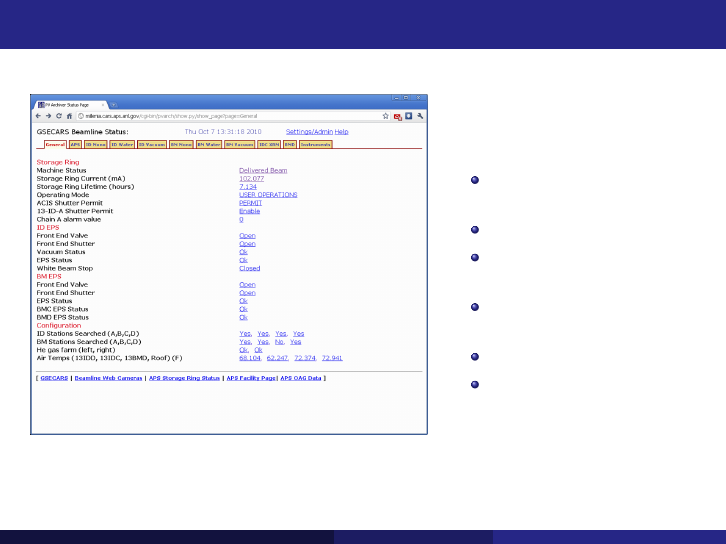
Epics Data Archiver – Epics+Python+MySQL+Apache
Main features:
Web interface to current
PV values.
& 5000 PVs monitored
Data archived to MySQL
tables.
templates for status web
pages
plots of historical data
web-definable email alerts
PV values displayed as html links to Plot of Data
Web-based Data Archiver M Newville CARS, UChicago Channel Access with Python: 24-Oct-2014
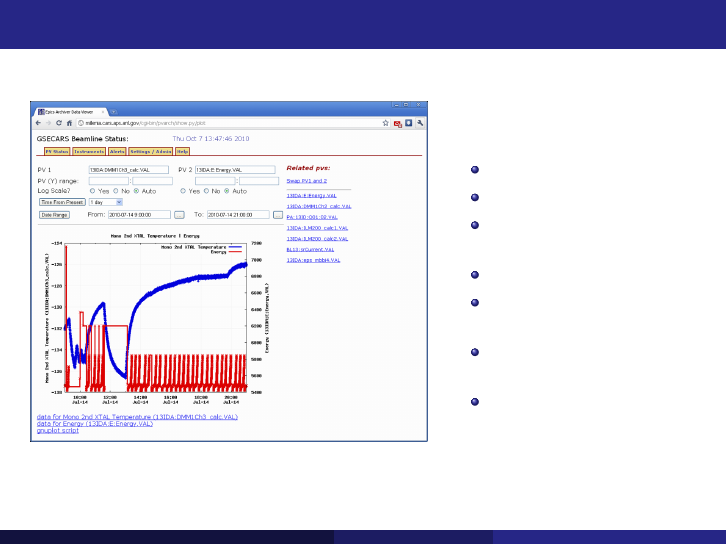
Epics Archiver: Plotting Historical Data
Plots:
default to past day
using Gnuplot (currently)
Plot “From now” or with
“Date Range”
Plot up to 2 PVs
“Related PVs” list for
common pair plots
pop-up javascript Calendar
for Date Range
String labels for Enum PVs
Web-based Data Archiver M Newville CARS, UChicago Channel Access with Python: 24-Oct-2014

GUI Controls with wxPython
Many PV data types (Double, Float, String, Enum) have wxPython widgets, which
automatically tie to the PV.
Sample wx widget Code
from epics import PV
from epics.wx import wxlib
# text controls: read-only or read/write.
txt wid = wxlib.pvText(parent, pv=PV(’SomePV’),
size=(100,-1))
tctrl wid = wxlib.pvTextCtrl(parent, pv=PV(’SomePV’))
# enum controls: drop-down or toggle-buttons
ddown wid = pvEnumChoice(parent, pv=PV(’EnumPV.VAL’))
btns wid = pvEnumButtons(parent, pv=PV(’EnumPV.VAL’),
orientation=wx.HORIZONTAL)
# float control: values restricted by PV limits.
flt wid = wxlib.pvFloatCtrl(parent, size=(100, -1),
precision=4)
flt wid.set_pv(PV(’XXX.VAL’))
pvText read-only text for Strings
pvTextCtrl editable text for Strings
pvEnumChoice drop-down list for ENUMs.
pvEnumButtons button sets for ENUMs.
pvAlarm pop-up message window.
pvFloatCtrl editable text for Floats, can
enter only numbers that obey PV limits.
Others: Bitmap, Checkboxes, Buttons,
Shapes, etc
Mixin classes help extending other wx Widgets (Many from Angus Gratton, ANU).
Function Decorators help write code that is safe against mixing GUI and CA threads.
wxPython GUI Controls M Newville CARS, UChicago Channel Access with Python: 24-Oct-2014
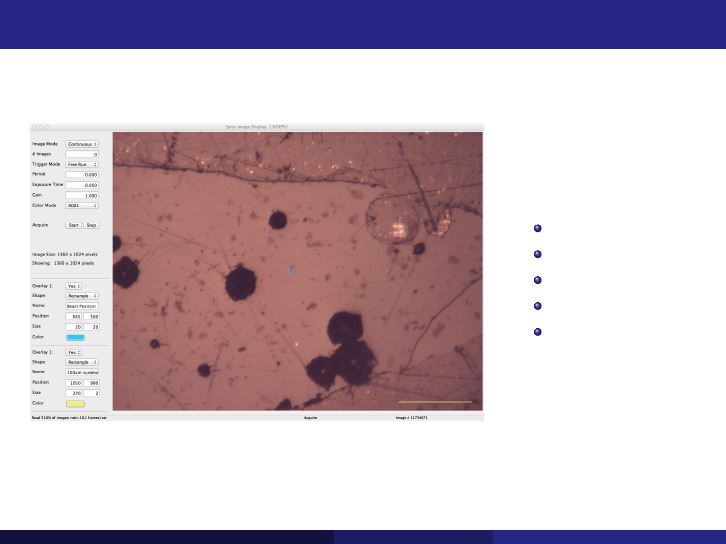
Some Epics wxPython Apps:
Simple Area Detector Display: A 1360 × 1024 RGB image (4Mb) from Prosilica GigE camera.
Works with any
areaDetector Image.
Includes basic controls:
trigger mode
exposure time
gain
color mode
start /stop
acquisition.
Click-and-Drag on Image
Zooms in, using ROI
plugin.
Displays at about 15 Hz: slightly slower than ImageJ.
wxPython GUI Controls M Newville CARS, UChicago Channel Access with Python: 24-Oct-2014
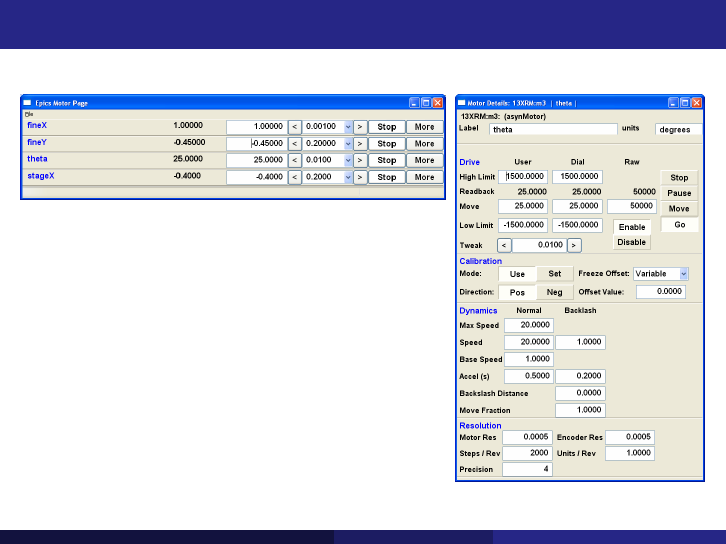
wx Motor Controls
MEDM-like Motor Display, except
much easier to use.
Entry Values can only be valid number. Values
outside soft limits are highlighted.
Tweak Values are generated from precision and
range.
Cursor Focus is more modern than Motif.
More Button leads to Detail Panel . . .
wxPython GUI Controls M Newville CARS, UChicago Channel Access with Python: 24-Oct-2014

Custom Application: Sample Stage
A custom GUI for controlling a six-motor Sample Stage:
Named Positions Positions can be saved by named and restored.
Sample Image (JPEG) captured at each saved position (either Web
Camera or area Detector image).
Simple Configuration with Windows-style .INI file.
Useful for my station, but definitely beamline specific.
wxPython Applications M Newville CARS, UChicago Channel Access with Python: 24-Oct-2014
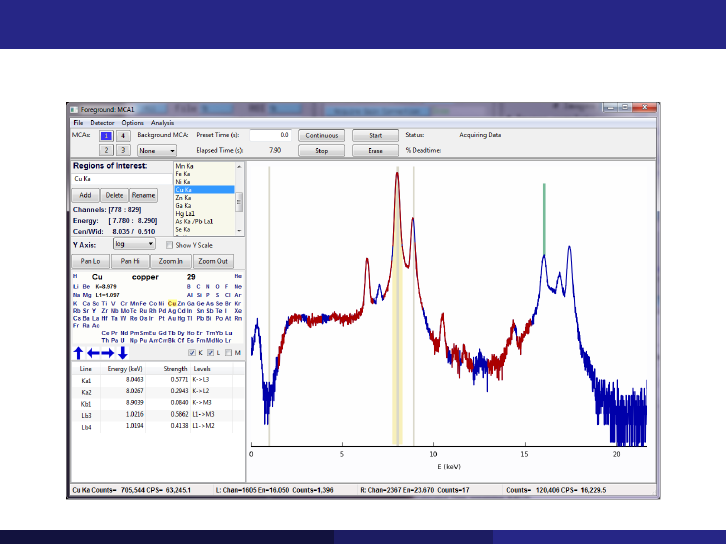
X-ray Fluorescence Detector Control / Display
A GUI for controlling XRF detectors and viewing XRF data.
wxPython Applications M Newville CARS, UChicago Channel Access with Python: 24-Oct-2014

PV StripChart Application
Live Plots of Time-Dependent PVs:
Interactive Graphics,
Zooming.
Set Time Range, Y-range
Set log plot
Save Plot to PNG, Save
Data to ASCII files.
Epics PV Stripchart M Newville CARS, UChicago Channel Access with Python: 24-Oct-2014
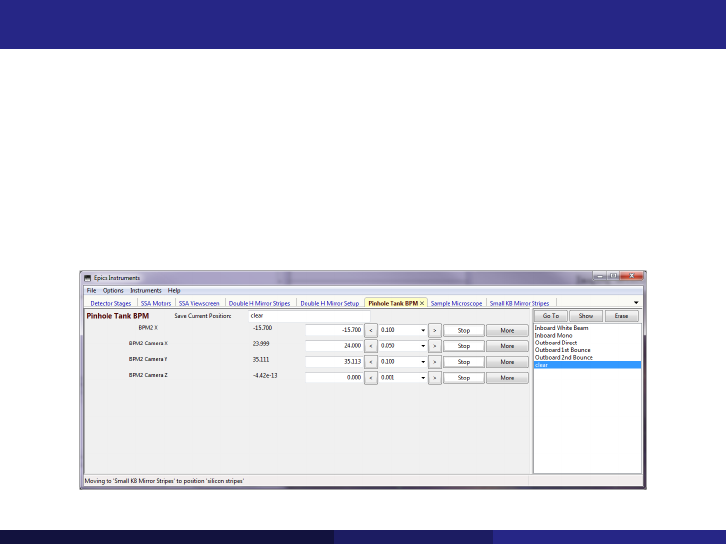
Epics Instruments: Saving Positions for Sets of PVs
Epics Instruments is a GUI application that lets any user:
Organize PVs into Instruments: a named collection of PVs
Manage Instruments with “modern” tab interface.
Save Positions for any Instrument by name.
Restore Positions for any Instrument by name.
Remember Settings all definitions fit into a single file that can be loaded later.
Typing a name in the box will save the current position, and add it to the list of positions.
Multiple Users can be using multiple instrument files at any one time.
Magic ingredient: SQLite – relational database in a single file.
Epics Instruments: SQLite M Newville CARS, UChicago Channel Access with Python: 24-Oct-2014
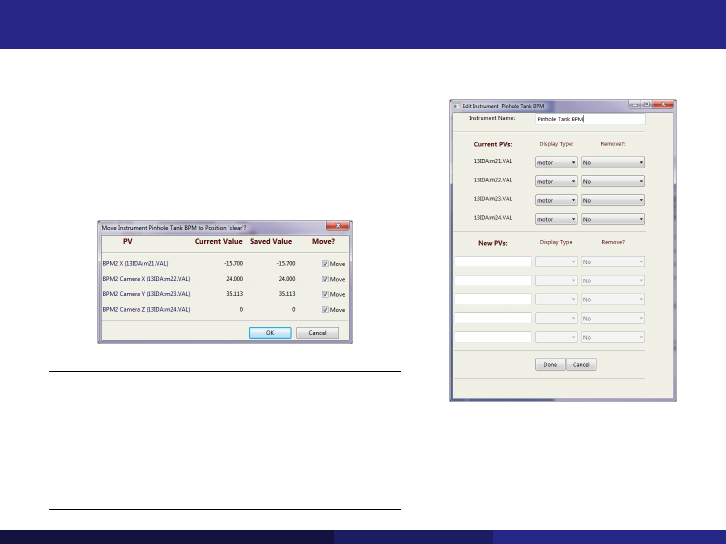
Epics Instruments: A few more screenshots
Save/Restore for motor or regular PVs.
At startup, any recently used database files
can be selected.
On “Go To”, settings can be compared with
current values, and selectively restored:
Server Mode: An application can listen to a
simple Epics Record.
This allows other processes (IDL, Spec, . . . )
to restore instruments to named positions by
writing to a couple PVs.
Edit screen to set PVs that
make up and Instrument.
Epics Instruments: SQLite M Newville CARS, UChicago Channel Access with Python: 24-Oct-2014

StepScan: Simple Scans with PyEpics
The stepscan module provides tools needed for step scans, similar to Spec or Epics SScan
Record.
Simple Scan in Python
import numpy
from epicsapps.stepscan import (StepScan, Positioner,
Counter, ScalerDetector)
scan = StepScan()
x = Positioner(’13IDE:m1’)
x.array = numpy.linspace(0, 1, 21)
scan.add_positioner(x)
scan.add_detector(ScalerDetector(’13IDE:scaler1’))
scan.add_counter(Counter(’13IDE:m3.RBV’))
scan.add_extra_pvs(((’Ring Current’, ’S:SRcurrentAI.VAL’),
(’Ring Lifetime’, ’S:SRlifeTimeHrsCC.VAL’)))
scan.run(filename = ’simple_scan.001’)
Borrows many concepts from Epics
SScan Record, but is pure Python.
Positioners: any Epics PV.
Detectors: Epics Scaler, Mca,
Multi-Element Mca Record,
AreaDetector so far.
Writes ASCII column file, expects
AreaDetector to write its own data.
Scanning with Epics and Python M Newville CARS, UChicago Channel Access with Python: 24-Oct-2014

General Step Scanning Concepts, Terms
Borrowing as much from Epics Scan Record as from Spec:
A scan is a loop that contains:
a list of Positioners to set at each point.
a list of Triggers to start detectors.
a list of Counters to read.
A list of Extra PVs to record at
beginning of scan.
pre scan() method to run before scan.
post scan() method to run after scan.
breakpoints a list of indices to pause
and write data collected so far to disk.
at break() method to at each
breakpoint.
scan loop, approximately
# set positioners, triggers, counters,
# and array(s) of positions
read_extra_pvs()
run_pre_scan()
for i in range(scan_npts):
for p in positioners:
p.move_to_pos(i) # use put-callback
while not all([p.done for p in positioners]):
epics.poll()
for t in detectors.triggers:
t.start() # use put-callback
while not all([t.done for t in detectors.triggers]):
epics.poll()
for counter in detectors.counters:
counter.read()
if i in breakpoints:
write_data()
run_at_break()
# loop done, write file
write_data()
run_post_scan()
Scanning with Epics and Python M Newville CARS, UChicago Channel Access with Python: 24-Oct-2014

Positoner and Detector Classes
Positioners:
unlimited number
uses full array of points for each
Positioner.
not start/stop/npts.
multidimensional scans are not
inner and outer. This allow
non-rectangular scans.
can alter integration time per
point: dwell time for each detector
is a Positioner.
can put in attenuators, filters, etc
for certain points, etc.
use breakpoints to write out
portions of multi-dimensional scans.
Detectors:
unlimited number
a Counter can store any Scalar PV.
No waveform PVs, yet.
a Trigger starts a detector.
ScalerDetector sets trigger, dwelltime
PV, add counters for all named
scalers channels.
Option to use calc record.
McaDetector sets trigger, dwelltime
PV, adds all named ROIs as counters.
AreaDetector sets trigger, dwelltime
PV, saves .ArrayCounter RBV.
Expects detector to save data, saves
Add pre scan()/post scan() methods
to put detectors in correct modes.
Scanning with Epics and Python M Newville CARS, UChicago Channel Access with Python: 24-Oct-2014

Spec-like Scans
A simple, Spec-like scan:
ascan in python
from epicsapps.stepscan import SpecScan
scan = SpecScan()
scan.add_motors(x=’13IDE:m9’, y=’13IDE:m10’, ...)
scan.add_detector(’13IDE:scaler1’, kind=’scaler’)
scan.add_counter(’13IDE:ao1’, label=’A_Counter’)
scan.filename = ’simple_scan.001’
scan.ascan(’x’, 10, 11.0, 41, 0.25)
# scan.lup(’y’, -0.1, 0.1, 21, 0.5)
# scan.mesh(’x’, 10, 10.5, 11,
’y’, 0, 0.5, 11, 0.5)
# scan.d2scan(’x’, -1, 1, ’y’, 0, 1, 41, 0.25)
ascan(), a2scan(), a3scan(),
dscan(), d2scan(), d3scan(),
lup(), and mesh(),
Motors: any Epics PV.
Detectors: Epics Scaler, Mca,
Multi-Element Mca Record,
AreaDetector so far.
currently writes ASCII column file,
but not exactly a “Spec File”.
no live plotting, yet . . . (in progress).
built on top of more general Step
Scanning module.
Can use an INI file to save / load
configuration of Positioners and Detectors.
Scanning with Epics and Python M Newville CARS, UChicago Channel Access with Python: 24-Oct-2014

Scan GUIs for defining and running scans
Building on-top of the Stepscan code:
Many beamlines want GUI forms for users to set up and remember scan parameters, and
do different sorts of scans (ascan, mesh, EXAFS, etc).
NOTE: This is a work in progress... needs more testing, but most things are working.
Scanning with Epics and Python M Newville CARS, UChicago Channel Access with Python: 24-Oct-2014
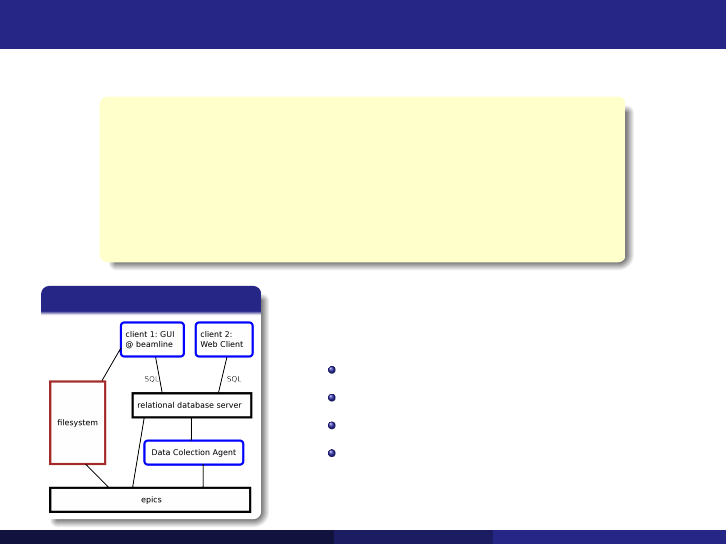
Overall Scan Architecture
How the Scan GUI actually runs the scan:
The GUI puts a JSON-encoded strings of scan parameters into a
Postgres database.
A server process monitors the database, running scans when
requested. This server saves the file, and posts real-time data
back into the database.
Clients can read this data from the database to display it.
Data Collection Scheme
Relational Database Management Systems (like
Postgres) are designed with
multiple simultaneous clients
data integrity
access security layers
cmultiple programming languages
in mind. SQL becomes the communication
layer between Clients and Server.
Scanning with Epics and Python M Newville CARS, UChicago Channel Access with Python: 24-Oct-2014

Scanning Application: What’s next?
The Scanning GUI is a work in progress
Current Status / To-Do list:
GUI to configure/store scan parameters works.
Running and displaying simple scans works.
Postgres DB used for client/server communication.
Real-time plot works. Peak analysis, “move to cursor
position”, etc in progress.
Embedded “macro language” exists, needs more testing.
Suggestion, ideas, collaboration would be welcome!
Scanning with Epics and Python M Newville CARS, UChicago Channel Access with Python: 24-Oct-2014

PyEpics: Epics Channel Access for Python
near complete interface to CA, threads, preemptive callbacks.
works on linux-x86, linux-x86 64, darwin-x86, win32-x86 (base
3.14.12.1) with Python 2.6, 2.7, 3.3.
reasonably well-documented and unit-tested.
easy installation and deployment.
high-level PV class, Devices.
GUI support (wxPython mostly, some PyQt support).
A few general-purpose applications, more in progress.
http://github.com/pyepics
http://github.com/pyepics/epicsapps
Acknowledgments: co-developer: Angus Gratton, ANU.
Suggestions, bug reports and fixes from Michael Abbott, Marco Cam-
marata, Craig Haskins, Pete Jemian, Andrew Johnson, Janko Kolar,
Irina Kosheleva, Tim Mooney, Eric Norum, Mark Rivers, Friedrich
Schotte, Mark Vigder, Steve Wasserman, and Glen Wright.
Conclusions M Newville CARS, UChicago Channel Access with Python: 24-Oct-2014

PyEpics: Exercises, Introduction
There are 36 sets of PVs: PREFIX = id01, id02, ..., id36.
NAME Type
PREFIX:shutter binary
PREFIX:dval1 double
PREFIX:dval2 double
PREFIX:dval3 double
PREFIX:ival1 integer
PREFIX:ival2 integer
PREFIX:ival3 integer
PREFIX:string1 epics string (max 40 characters)
PREFIX:string2 epics string (max 40 characters)
PREFIX:bo1 binary (0 / 1)
PREFIX:mbbo1 multi-bit binary (enum)
PREFIX:filename byte waveform (128 characters) – long filename
PREFIX:dwave double waveform (256 elements)
PREFIX:iwave integer waveform (256 elements)
PREFIX:image byte waveform (65536 elements)
Exercises M Newville CARS, UChicago Channel Access with Python: 24-Oct-2014

PyEpics: Exercises
These slides and instructions: http://cars9.uchicago.edu/epicsclass/
Data Logger #1 There are 3 double and 3 integer PVs are updated somewhat randomly.
Write a program to print out these values every second.
Data Logger #2 Modify your program to print out all 6 values when any of them
changes.
Shutter Watcher #1 The 36 shutter PVs are opening and closing periodically, somewhat
randomly. Write a program to print out when any shutter opens or closes.
Shutter Watcher #2 Measure how long each shutter is open during a 5 minute interval
and print out a table of result.
Create a Device Create an Epics Device from the 3 double PVs, 3 integer PVs, the
mmbo PV, a regular string PV, and the filename PV.
Working with waveforms Read one of the updating dwave, iwave, and image PVs into a
numpy ndarray and find the mean, sum, and standard deviation, and plot
the array.
I’ll show a solution to these (in order) every 20 minutes.
To use Anaconda python (more recent version) on the APS Share, type
source /local/newville/anaconda.sh
Exercises M Newville CARS, UChicago Channel Access with Python: 24-Oct-2014
